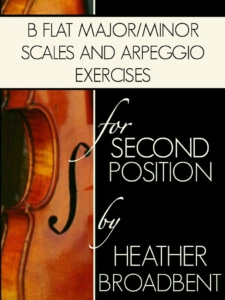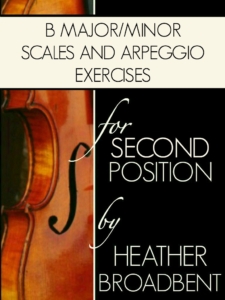How to Play B flat, B, C and D Two Octave Major Scales in 2nd Position on the Violin
Do you find it difficult to play in second position on the violin? The best way to get to know a specific position is to play scales across the instrument. In this post, learn How to Play B flat, B, C and D Two Octave Major Scales in 2nd Position on the Violin.
The thumb has 2 homes in 2nd position
Before we get into 2nd position scales on the violin, there is one important thing we need to discuss and that is that second position is a very unique position because our thumb has two different homes. Every other position has one home for the thumb but second position has two homes.
When we start second position on the G string with a B flat, the thumb is in its first home. When we play B natural our thumb also moves with that first finger into its second home. The thumb does not stay in one place.
2nd position scales sheet music
In case you would like to see these notes written out for the scales I discuss in this blog post, click here to have the PDF sent to your inbox. After you receive the 2nd position scale sheet music in an email, be sure to come back to this post for the tutorial.
Why is 2nd position so difficult to learn
The difficulty with second position is the fact that it’s so close to First Position. It’s only one step off so many violinists that I work with that struggle with second position they want to revert into reading like first position. So this is why I truly suggest that you visualize the notes in your mind how they look on the staff, think your note names, always know your note names because it’s how you relate to that pitch. If you don’t know the name, you just know the finger, it’s not a good connection to the pitch that you’re playing but if you connect to the pitch it’s more likely gonna be in tune.
B Flat Major Scale
B flat major is our first scale and second position and this scale has two Flats, B flat and E flat.
Start by understanding your hand frame in second position, checking your 1’s and 4’s on every string.
We’ll start with our first finger on B flat and I’m going to walk you through the finger patterns. Keep this as a guideline for the physical feeling but don’t use it as a crutch without thinking about your note names and visualizing how they look on the staff.
G and D string
3 & 4 touch
A and E string
2 & 3 touch
Now what is really pretty beautiful about this is once you understand this finger pattern this applies to every single scale you could play in any position on the violin as long as you start with your first finger.
So once you learn this you can apply it to every other position.
Practice the corresponding B Flat Major Arpeggio.
Listen that every single note that resonates with an open string is really resonating and in tune.
B Major Scale
Now don’t freak out! B major, yes, it has five Sharps but you’re going to be okay.
Our notes are B, C sharp, D sharp, E really think your note names visualize F sharp, G sharp A sharp B and then we have C sharp, D sharp, E, F sharp G sharp, A sharp, and B.
Always check your hand frame first:
We have octave B’s on the lower two strings. Make sure again you’re set up really nice and strong between the one and four with a balanced left hand. Then we have octave F sharps and octave C sharps.
Play your scale and the corresponding arpeggio.
C Major Scale
The C Major scale in 2nd position is little bit different because we’re going to start with our second finger so the finger pattern is NOT going to be the same.
C major scale doesn’t have any sharps or flats, but don’t take that for granted that it is going to be easier to play in tune. C major has its own challenges for intonation on the violin especially in second position.
G and D strings
no fingers touch
A and E strings
3 & 4 touch
- Review the hand frame
- Practice the scale
- Practice corresponding apreggio
D Major Scale
The final scale for today in second position is the D major scale. How we’re able to play a D major scale in second position is the fact that we’re going to extend our fourth finger at the end.
We start with the third finger on the G string so you can find that and check that your third finger matches up with your open D.
G string
no fingers touch
D string
1 & 2 touch
A string
1 & 2 touch (Be sure only your finger extends to the 4 and that you’re not moving your hand to find that extended four.)
E string
half step occurs between the regular 4 and extended 4
- Review the hand frame
- Practice the scale
- Practice corresponding apreggio
Practice Order
Practice B Flat and C Major scale one after the other due to the home of the thumb.
Adjust the thumb to the new home and practice B and D Major Scales.
Have fun practicing!
Happy Magical Practices,
Heather is a classically trained concert violinist residing in Bulgaria. She received her BM violin performance degree from CU-Boulder, studied with top teachers including Rachel Barton Pine. Heather has held leadership positions with multiple orchestras in the Greater Chicago-Milwaukee area. She has instructed millions of violinists globally via Youtube videos, online academies, group coaching and one on one sessions. Heather’s students have won multiple awards, concerto competitions, held concertmaster positions in orchestras and even performed in Carnegie Hall. Heather is an advocate of a holistic violin lifestyle – putting one’s mind, body and spirit as a violin journey priority.
Please share in the comments which above tips you will be implementing into your daily practices sessions.







Leave a Reply
Want to join the discussion?Feel free to contribute!